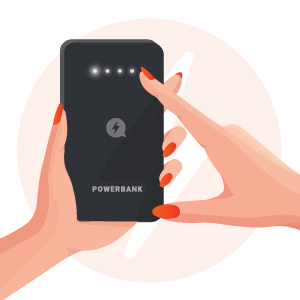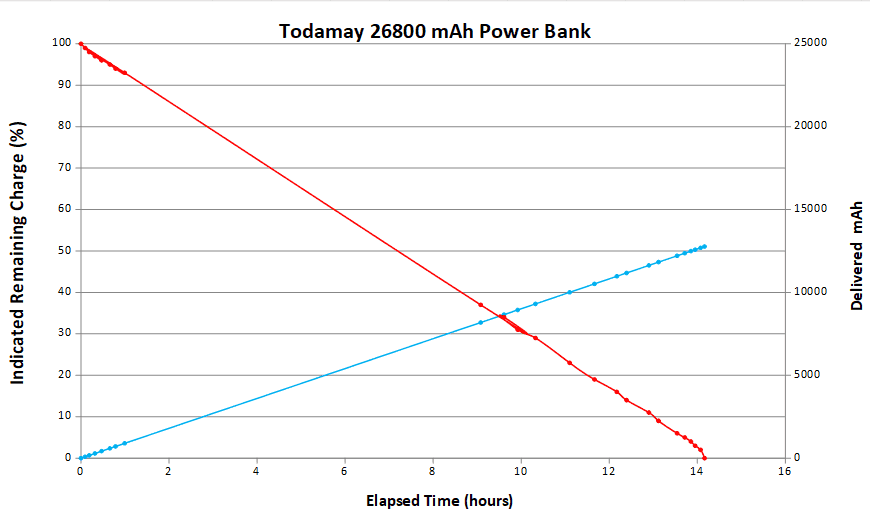 It is undeniable that power banks have made our lives easier when it comes to extending the battery life of their portable devices, especially smartphones, and tablets.
It is undeniable that power banks have made our lives easier when it comes to extending the battery life of their portable devices, especially smartphones, and tablets.
However, a prevalent scenario is when users proceed to charge their cell phones only to find out that the battery of their power banks has drained “ahead of time”.
Most people have logically deduced that there is a difference between the power bank capacity and the actual power transferred to their cell phones.
They have also noticed that this capacity is not sufficient to charge their cell phones the number of times they have initially calculated, leaving them disappointed.
A common assumption is that, for example, a 10000mAh will be able to charge a 2500mAh phone battery exactly 4 times. However, this is not the case. Let’s see why.
Understanding The Real Capacity Of a Power Bank
Most power banks are created using Li-ion batteries, which have an average voltage of 3.7V. This is the voltage that manufacturers use to calculate the theoretical capacity of their power banks. So when you see a 10000mAh capacity power bank, it’s based on the 3.7V value.
However, when power banks are used to charge other devices, they don’t supply 3.7V. Instead, they need to supply 5V, which is the required USB standard. If you were to look at one of the output ports of any power bank, most likely you would see one of the following values printed next to it: 5V/1A, 5V/2A, 5V/2.4A, etc. Always 5V and not 3.7V.
So when the native 3.7V is converted to the supplied 5V, the capacity also drops. The 5V capacity can be calculated with the following formula:
For example, if we were to take a 10000mAh power bank, its actual capacity would be:
5V capacity= (3.7V * 10000mAh) / 5V = 7400mAh
As you can see, the supplied capacity is actually 26% smaller than the theoretical, advertised capacity.
But that’s not all! The real capacity of the power bank is even smaller!! This is because of yet another factor that needs to be accounted for: power losses.
Understanding Power Losses
As previously mentioned, power banks have a native 3.7V, but they actually need to supply 5V. Thus the voltage is elevated through a converter circuit placed in between the power bank and the charged device, incurring initial power losses.
In addition, the batteries of electronic devices are lithium made and they also operate at 3.7 V, which means that another power conversion takes place, generating even more losses.
And last but not least, the USB cable also causes power losses due to its internal resistance.
All these factors are summed up and they are expressed as an efficiency rating, which is generally between 80% and 90%. The efficiency rating varies from one power bank to another, although many manufacturers opt not to disclose it to customers.
How To Calculate The Actual Capacity
As we have seen, both voltage conversion and efficiency ratings are factors to take into account. Then, the actual power capacity can be obtained using the following simple formula:
For example, the 10000mAh Xiaomi Mi Power Bank PRO is one of the best-reviewed power banks in the market because it has an efficiency rating of up to 93%, which is actually stated in the technical specifications under the term “conversion rate”.
Then the actual capacity calculation is as follows:
Actual capacity = 3.7V x 10000mAh x 0.93 / 5V = 6882mAh
This result indicates that only 68.82% of the advertised capacity can be supplied to devices.
However, it is interesting to notice that if the power bank had an efficiency factor of 0.9, the results would be 0.666; in other words, two-thirds.
Therefore, if you want to know the real capacity of a power bank, but you don’t know its efficiency coefficient, then you can estimate that 2/3 of the theoretical capacity is its actual capacity. However, the actual capacity will differ from manufacturer to manufacturer. One study has shown that you can find a difference of as much as 40% between the advertised and the actual capacity of a power bank.
How To Test The Actual Capacity Of a Power Bank
It is impossible to know the exact internal capacity without disassembling the power bank, but regardless, it is possible to measure the USB output.
For carrying out this procedure, a USB cable is connected to a full-charged power bank, while the other one is cut, insulating the four colored wires. A 5Ohm resistor is then connected to the black and red terminals (1 and 4). A current of 1Amp or 1000mA will circulate through it as 5V is the standard USB output.
The voltage is monitored with a voltmeter for a determined number of hours according to the power bank capacity. If the power bank battery lasts for the same number of hours as listed in the capacity, then it is the actual capacity. In reality, this capacity is less due to power losses.
For example, for a power bank of 12000mAh, a constant current load of 1 Ampere per hour will be drawn for 12 hours. However, the voltage should drop to between 3V and 4V at an earlier time, approximately two-thirds of the capacity (8 hours), which indicates the power bank’s real capacity.
As for the efficiency rating, it can be obtained using the formula to calculate the actual capacity:
Provided that the battery supplied power at 5V for 8 hours, the efficiency rating will be:
Efficiency (in decimal) = 8000mAh x 5V / 3.7 V x 12000mAh = 0.90
Check out this dedicated article for more methods on testing the capacity of a power bank.
From Our Readers’ Experience Regarding ‘Real vs Rated Capacity’
We’ve been contacted by one of our readers, who tested their 25000mAh power bank only to be surprised that it actually had a capacity of 10758mAh. With his accord, we’re publishing his findings so that other readers might learn from this hands-on experience:
“It turns out that the way I tested my power banks was with exactly the same test rig. I happened to have a 5-ohm resistor with a power rating of 5 watts just lying around, so I cut it into a USB cable and wired it up (being careful to ensure that the resistance of my leads was very small compared to 5 ohms).
My first step was to carefully measure the actual resistance of the resistor when it was hot from carrying a 1 amp current. I then hooked up my resistor to the output of the power bank and monitored the indicated remaining charge in the power bank (the Todamay power banks have a digital display indicating remaining charge), along with the actual voltage across the resistor (which to Todamay’s credit was remarkably constant across the full range of remaining charge in the power bank). Knowing the voltage across the resistor and knowing the resistance gives me the current.
I’ve attached the spreadsheet I used to record and analyze the data (see attached). The first page of the spreadsheet, titled “Discharging #1”, is the data taken during the discharging of the power bank from its “as shipped” charge state of 77% to 0%. The second page of the spreadsheet shows the process of charging the power bank from 0% to 100% charge. I did not monitor the power required to charge the power bank.
The third page, titled “Discharging #2”, is the meat of the matter. It shows the actual mAh that was delivered into the resistor, from 100% to 0% charge of the power bank. As you can see, it only delivered 12,769 mAh, not 26,800 mAh as advertised. One thing of note is how accurately the power bank senses how much capacity it has remaining.
This is reflected in the nearly linear red curve showing the indicated remaining charge. I was quite surprised by this. Either the voltage vs remaining capacity curve of these Li-polymer (?) batteries is extremely well known and well reproducible, or they have an internal logic that calibrates to the actual voltage vs capacity curve of the installed batteries. Either way, I was impressed.
The charging of the power bank was done with an Apple 5V, 2.1A power adapter. I say this because the charging plots may help your readers get an idea of how long it takes to charge the device from a typical power adapter.
If we make the somewhat shaky assumption that the adapter was putting out 2.1 A at 5V for the entire charging process then we see from the page named “Charging #1” that the charging process required 116 Wh of energy.
The stated stored capacity of the unit is 99.1 Wh. But before you go thinking that the charging process was 85% efficient you should keep in mind that the power bank’s internal circuitry does not fully discharge the batteries before shutting down, that is, when the display reads 0% the batteries are not fully drained (as attested to by the constant voltage output during the draining measurement). ”

Download the full spreadsheet here
Are The ‘Rated Capacity’ and ‘Advertised Capacity’ The Same Thing?
Yes, the terms “rated capacity” and “advertised capacity” are used interchangeably when talking about power banks. Both terms refer to the maximum amount of electric charge a power bank can theoretically store and supply, calculated based on the nominal voltage of the lithium-ion batteries inside, typically 3.7 volts.
However, we previously explained, that the actual amount of power that the power bank can deliver to a device, such as a smartphone or tablet, via a 5-volt USB output is less than this rated or advertised capacity due to factors such as voltage conversion and power losses during transmission. Hence, it’s important to understand that the “actual capacity” delivered to the device can be lower than the “rated” or “advertised” capacity.
Conclusion
Overall, for choosing a power bank that adjusts to individual needs, it is important to consider a bigger capacity than the one the device has; but this is not the sole indicator. In fact, users should be aware of efficiency rating and power conversion to avoid deception. Nonetheless, anyone can estimate the actual capacity only by considering 66.6% of the advertised value.
